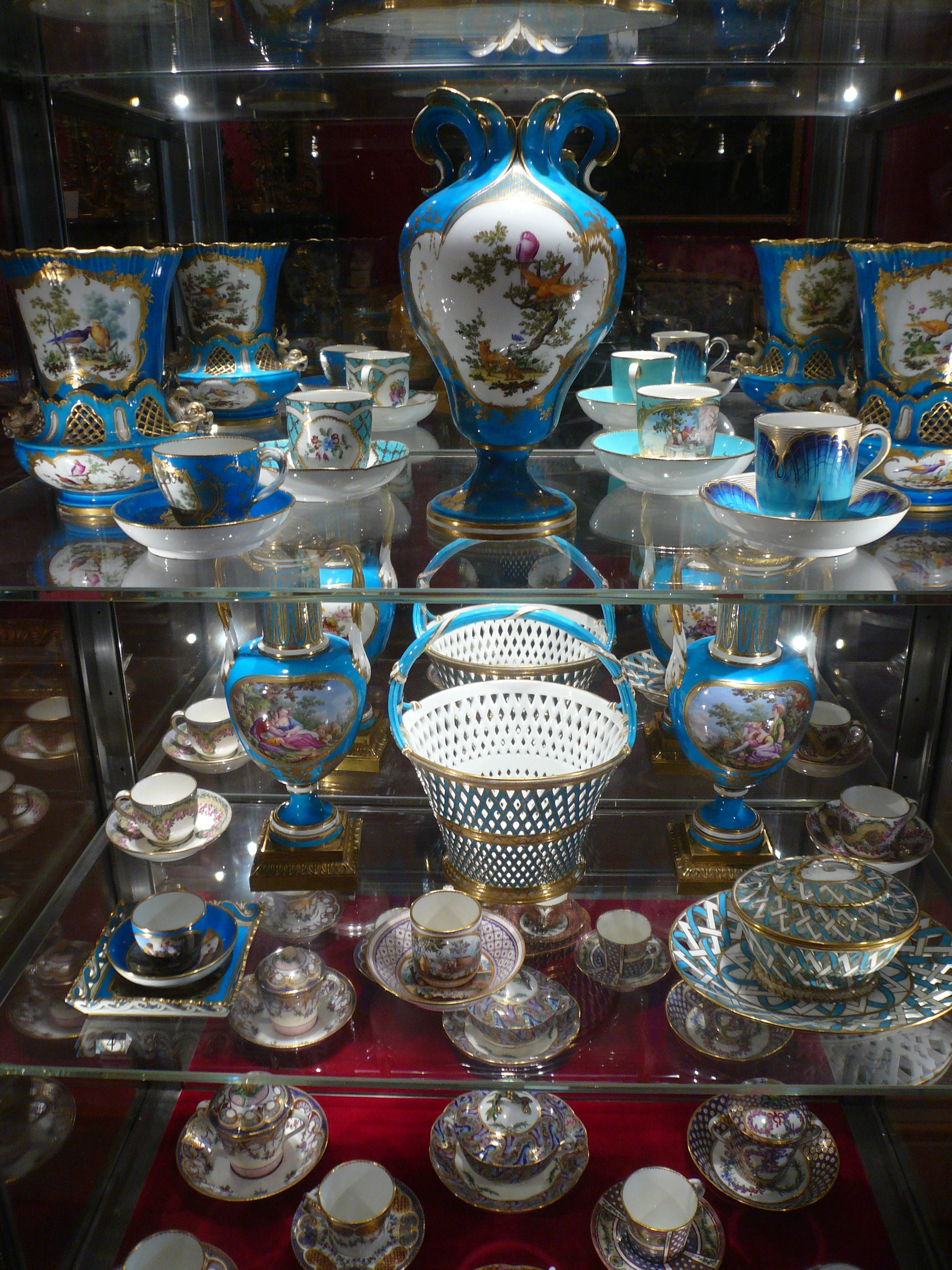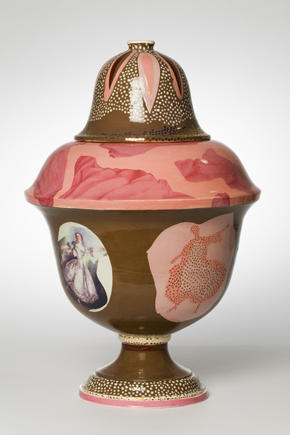Palimpsests of Pattern: The Painterly Practice of Charlotte Hodes
By Louise Wheeler
The multi-media practice of the contemporary artist and Professor of Fine Arts (at London College of Fashion, University of the Arts London), Charlotte Hodes is mesmeric and a playful subversion of decorative art and the role of the female subject in art history. Wave: Rosette Red from Charlotte Hodes’s 2009 exhibition “Silhouettes and Filigree,” (shown at the Marlborough Gallery in London), exemplifies Hodes’s exuberant and intricately ornate use of paper-cutting to create images of intense detail and captivating complexity. In her layering of paper-cuttings, from paper that she colours herself, Hodes creates vibrant palimpsests meditating on the endless possibilities for patterned form; indeed, her use of pattern is reminiscent of the infinite structure of Islamic ornament, woven and sculpted into a transcendent climax. Hodes uses a scalpel to define lines in paper. In this way, Hodes’s use of paper-cutting crosses the boundary between painting and sculpture. She retains the flat linearity of the picture plane; yet, by building up layers with delicate fragments of paper, her work is inherently sculptural and seeks to move away from any sense of a two-dimensional surface plane. Moreover, Hodes attempts to reconfigure the idea of the unified image in her use of paper-cuttings and collage, therefore establishing her practice within a dialogue about the pictorial tradition in Western art history.
Charlotte Hodes, Wave: Rosette Red, sequence of six papercuts, papercut, 112 x 145 cm, 2010.
https://charlottehodes.com/portfolio/silhouettes-and-filigree/
Beginning as a painter, Hodes studied at the Brighton School of Art from 1977-78, before attending the Slade School, University College, London from 1978-1984. Hodes was inspired by one of her teachers, Paula Rego, who had a preoccupation with the female body and the psychological response to the presentation of the female form. Importantly, it is Hodes’s awareness of, and responses to, the legacies of art history that are so fundamental to her work. She has cited influences from a variety of artists and works, including Sonia Delaunay, Odilon Redon, and the Transparencies series by Francis Picabia. These influences attest to Hodes’s insistence on approaching all of her multi-media work from the perspective of the painter. The painterly aspect is also evident in her construction of composition, colour, and her employment of material in fluid, succinct forms. However, Hodes’s commitment to her own path in developing her own technique has resulted in her work embracing the female perspective, with the majority of her pieces featuring a female protagonist who acts as a formal anchor to a choreographed dance of designed patterns placed around her.
Charlotte Hodes, Proposition 36 Pillar, cut printed and painted papers, 63.2 x 93.8 cm, 2014.
https://charlottehodes.com/portfolio/the-grammar-of-ornament/
The figures of women are the defining and re-occurring motif in Hodes’s oeuvre, whether painted, collaged, papercut, or printed. Their bodies are always slightly re-formulated but nonetheless they retain similar morphed elements. Hodes has described this female presence, in a decidedly feminist vein, as a figure of a woman in charge of her direction, but she also has a suggestion of disconnectedness; she is continuously moving from one centre to the next. Hodes’s intention is that her figurative imagery should be suggestive and symbolic and she grounds her presentation of the female form in ambiguity. Her presentation can be read as asserting control over, as well as enjoying pleasure in, her patterned world. Additionally, the figure can be read as a blank presence amongst an environment of chaotic phenomena, attempting to forge an identity. In representing the female figure, Hodes is re-assessing the placement of the female form within the art historical canon by releasing the female subjectivity from a historical passivity. Hodes makes drawings, sometimes from photographs, of her body in order to create her female silhouettes. This method suggests a subversion of female bodies as depicted historically by male artists, as Hodes’s collage and paper-cutting elements become literal embodiments of her own form. This further demonstrates Hodes’s theme of re-conceptualising notions of femininity that are typically associated with ‘decorative’ elements or craft media such as embroidery or quilting. Hodes’s use of a larger scale and more painterly approach mirrors her disruption of the traditional hierarchy of art historical genres by exulting the decorative or ‘feminine’ crafts into ‘high’, pictorial art. Once again, it is apparent that Hodes is conscious of the placement of women physically and psychologically, throughout art history, through her series of paintings from her 1999 exhibition, “Surfing History,” exhibited at the Eagle Gallery, London. In the series, Hodes makes overt reference to iconic art historical representations of women, from Elizabeth I to Dürer’s Eve.
Charlotte Hodes, Repose, oil on canvas, 30 x 28 cm, 1999.
Hodes’s attempt to bridge the divide between ‘high’ art forms with traditionally perceived ‘feminine’ forms of craft manifests itself most clearly in her ceramic works. Hodes is not herself a ceramicist, but she creates her designs in collaboration with studios and factories, such as her work with the Spode Ceramic Factory from 1998-2004. In keeping with her approach as a painter, Hodes has spoken of her treatment of ceramic surfaces as another form of the canvas surface, and thus creates her ceramic ware in a similar method to a painted composition. In particular, Hodes is drawn towards ceramics and tableware as emblems of domesticity and femininity, with her female protagonist appearing on various designed plates, vases, and dishes. To transpose her collaged and cut-out imagery, Hodes employs fragments of digitally printed or silkscreen ceramic transfers. Hodes’s ceramic work also references canonical artworks, inspired by her residency at the Wallace Collection in London from 2005-07, in which she was inspired by the collection’s Fête Galante paintings, and more notably the Sèvres porcelain.
The multi-disciplinary approach of Charlotte Hodes is ultimately united by her painter’s eye, making her work visually joyful to behold. Yet, behind the aesthetic exuberance of Hodes’s work lies a deeper investigation into the formation of selfhood, the strategies of pictorial art, and the position of the female figure within art history. It is this combination of form and philosophical intent that makes Hodes’s work exemplary amongst contemporary artists creating today.
Bibliography
‘Charlotte Hodes.’ Interviewed by Stephanie Boulton; edited by Amy Goldfischer. Penn Women in Art Initiative. Womeninartinitiative.org. Accessed 02/02/2018. http://womeninartinitiative.org/interviews/charlotteHodes.html.
‘Charlotte Hodes, London, UK.’ Brooklyn Museum, Elizabeth A. Sackler Center for Feminist Art. Brooklynmuseum.org. Accessed 02/02/2018.
https://www.brooklynmuseum.org/eascfa/feminist_art_base/charlotte-hodes.
‘Charlotte Hodes: Profile.’ Charlottehodes.com. Accessed 02/02/2018. https://charlottehodes.com/profile/.
‘Charlotte Hodes: Self-Portrait as Ornament.’ Ruth Borchard Collection. ruthborchard.org.uk. Accessed 02/02/2018. http://ruthborchard.org.uk/collection/charlotte-hodes/.
‘Dressed in Pattern.’ Faculti.net. Accessed 02/02/2018. https://faculti.net/dressed-in-pattern/.
McKenzie, Janet. ‘Charlotte Hodes: Interview.’ Studio International. Published 21/07/2014. Accessed 01/02/2018. http://www.studiointernational.com/index.php/charlotte-hodes-interview- painter-female-form-grammar-ornament.
Westley, Hannah. ‘Now You See Me: Self-Representation in the Work of Charlotte Hodes.’ About Face. Accessed 02/02/2018. http://aboutfaceconceptsofportraiture.com/essay/now-you-see-me-self-representation-in-the-work-of-charlotte-hodes/.





